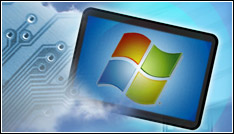Gartner Sees Healthy Growth In Operating System Market

The operating system market was worth £18.3 billion in 2010, predictably with Windows leading the way
Revenue from the worldwide operating system (OS) market grew 7.8 percent to $30.4 billion (18.3 billion) in 2010, according to Gartner.
And of course Microsoft Windows continued to lead the market by a wide margin.
Linux server and Mac OS were the fastest-growing sub-segments in the server and client OS segments, respectively, while Microsoft maintained its leading position in the overall OS market, with 78.6 percent market share.
Strong Client Demand
“Generally, client OSes outperformed server OSes and grew 9.3 percent in 2010, while the server OS segment grew 5.7 percent,” said Matthew Cheung, principal research analyst at Gartner, in a statement. “The long-pending demand for PC refreshment was unleashed as the economy stepped out from the economic turndown, which drove growth of client OSes.”
Among client OSes, Mac OS was the fastest-growing sub-segment in 2010 as the unit shipments of Mac desktop/laptop devices saw strong sales, although from a much-smaller basis, Gartner said. Windows client was still the largest client OS segment, with high-single-digit growth, particularly driven by adoption of Windows 7 and the imminent end of life (EOL) of Windows XP, Gartner said.
Mac OS grew 15.8 percent to a size of $520 million (£314 million) in 2010, fuelled by the strong sales of Mac desktops and laptops. Apple’s making of Mac OS as a “cool” client computing OS has attracted a group of loyal customers on Mac devices and platforms, Gartner said. And Apple’s continuous innovations in mobile devices, such as smartphones and tablets, have prompted sales of other Apple devices and will continue to drive Mac sales, the research firm said.
 “In the server OS market, Linux was the fastest-growing sub-segment in 2010 as end users adopted more open-standard systems,” said Alan Dayley, managing vice president at Gartner, in a statement. “Within the Unix OS market, IBM AIX had high single-digit growth, but Unix generally experienced modest or negative growth,” “The EOL threat for Unix OSes such as Tru64 and NetWare pushed the ‘other proprietary Unix’ sub-segment down 39.6 percent in 2010 as some vendors retired their proprietary Unix and moved users to more open systems.”
“In the server OS market, Linux was the fastest-growing sub-segment in 2010 as end users adopted more open-standard systems,” said Alan Dayley, managing vice president at Gartner, in a statement. “Within the Unix OS market, IBM AIX had high single-digit growth, but Unix generally experienced modest or negative growth,” “The EOL threat for Unix OSes such as Tru64 and NetWare pushed the ‘other proprietary Unix’ sub-segment down 39.6 percent in 2010 as some vendors retired their proprietary Unix and moved users to more open systems.”
The distant second- and third-place vendors behind Microsoft’s 78.6 percent market share in 2010 were IBM and HP, with 7.5 percent and 3.7 percent share, respectively. Oracle climbed up the ranking from No. 8 in 2009 to No. 4 in 2010 by acquiring Sun Microsystems’ Solaris business in April 2009.
PC Refreshment
Microsoft’s Windows client business had higher growth at 9.2 percent, compared with its Windows server business at 7.5 percent growth, the Gartner report showed. A new wave of PC refreshment after the economic recession was the major reason for the better-performing Windows client business. Windows 7 also gained market acceptance as the successor to Windows Vista and XP, Gartner said. The projected EOL of XP in early 2014 drove enterprises to accelerate migration to Windows 7 in the second half of 2010.
In an 22 April blog post, Microsoft announced that Windows 7 had sold more than 350 million licenses in the 18 months it has been available. In that post on The Windows Blog, Microsoft said: “Analyst firms like IDC estimate that more than 90 percent of businesses are currently in progress with their Windows 7 migrations. And we’ve seen that companies who have deployed Windows 7 save an average of $140 (£84) per PC per year – showing a 131 percent return on investment in just more than 12 months.”
Meanwhile, among the three OSes owned by IBM, AIX experienced the highest growth at 9.2 percent due to the popularity of Power Systems. The consolidation of the System p and System i platforms and the strategy to push more AIX contributed to the slow growth of System i at 2.7 percent in 2010, Gartner said.
Moreover, HP-UX was able to maintain modest growth at 3.7 percent in 2010. However, HP’s revenue from proprietary Unix and other proprietary OSs continued to decline because of the discontinuation of Tru64 and a decline in shipments of business-critical systems, such as NonStop and OpenVMS.
Also, facing the realities of the market, Oracle’s software revenue from Solaris declined 3.2 percent in 2010 as end users were skeptical about Oracle’s commitment to the Solaris platform – although the company made several announcements to clear this anxiety, Gartner said. Oracle’s Linux versions, also known as Unbreakable Linux, grew a small base almost 200 percent in 2010 – which also showed Oracle’s strategy to lessen its dependence on other vendors’ Unix or Linux OSes.
And, for its part, Red Hat has been dominating the commercial Linux server market, Gartner said. Revenue of Red Hat Enterprise Linux (RHEL) server license went up 18.6 percent to $592 million (£357 million) in 2010, claiming a 58.2 percent share of the Linux server market. Gartner analysts said the phenomenon demonstrates that the market has accepted Linux as a viable alternative to Unix and other proprietary OSes in mission-critical environments.